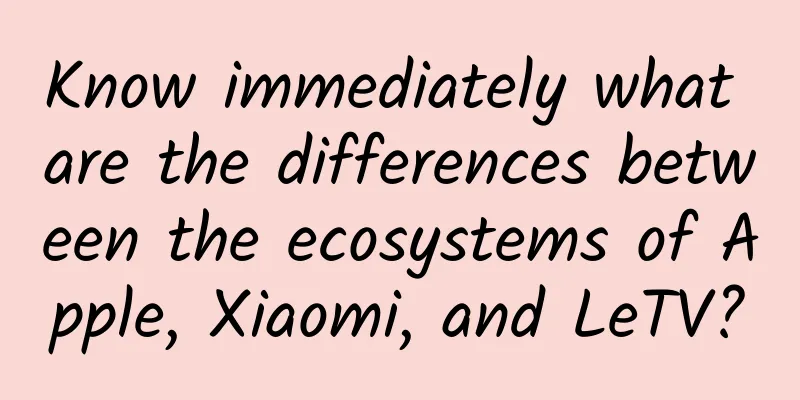Know immediately what are the differences between the ecosystems of Apple, Xiaomi, and LeTV?

|
1. Apple uses products such as iPhone, iPad, and iTunes to form a closed system, driving iTunes content consumption through hardware products and gaining long-term benefits; 2. Apple's streamlined business lines are more likely to form a closed-source ecosystem, while Sony's business lines are too complex, which increases the cost of connecting them and ultimately makes it difficult to form a unified ecosystem; 3. Xiaomi and LeTV, which are based on open source Android, are unlikely to form a closed system like Apple, and their revenue is more driven by hardware. Therefore, Xiaomi and LeTV are actively investing in content and hardware development to gain more revenue. Preface: They are copying the “Apple model” Apple's Q1 financial report for fiscal year 2015 shows that Apple's revenue for the quarter was $74.9 billion, of which hardware revenue was $61.7 billion and service revenue represented by iTunes was $4.8 billion. Software and hardware account for more than 96% of Apple's revenue, and Apple's unified ecosystem of software and hardware demonstrates amazing commercial value. Many domestic technology companies are also implementing this business model. In addition to Xiaomi, which is already on the road, LeTV also announced at its mobile phone launch conference a week ago that it would build its own ecosystem consisting of mobile phones, cars, and televisions. In addition to hardware products, the two companies have also invested heavily in content, e-commerce, and mobile services related to mobile phones. 1. Xiaomi Ecosystem: You would never have thought that it has invested in so many companies When Xiaomi was founded, Lei Jun initially designed a "triathlon" strategy for it, namely to use mobile phones, MIUI, and MiTalk to connect the hardware, software, and social services of the mobile market respectively, so as to achieve a unified experience. But the expected strategy cannot keep up with the market changes. Less than five years after the announcement of the "Triathlon", the markets of Mi Chat and MIUI were successively occupied by competitors. According to the data released by Xiaomi in September last year, the number of Mi Chat users was 70 million, but the number of monthly active users of WeChat exceeded 500 million last year. The situation of MIUI is also not optimistic. According to the statistics released by Flash Wizard last year, Xinfeng ROM surpassed MIUI to become the third-party system with the most flashing in 2014. The triathlon strategy formulated when Xiaomi was founded failed to keep pace, and mobile phones became the absolute core of Xiaomi. In this context, Xiaomi is actively developing strategic layout around mobile phones, enriching multiple content ecosystems such as audio and video, games, and reading, while also developing smart homes and mobile e-commerce, and investing in content production and mobile Internet services. 1. Content system - Video: In November 2014, Xiaomi and Shunwei Capital invested RMB 1.8 billion in iQiyi, becoming the second largest shareholder of iQiyi. In the same month, Xiaomi invested tens of millions of dollars in Youku Tudou, and Youku Tudou's self-made content will appear on Xiaomi's hardware terminals in the future. Earlier, Lei Jun also personally participated in the investment in the film and television production company Huace Film and Television. - Music: In August 2012, Xiaomi and Baidu Music reached a content cooperation; in January 2015, Xiaomi and Lei Jun's Shunwei Capital invested in the mobile radio application Lizhi FM, which will be deeply integrated with MIUI in the future. - Games: In February 2014, Xiaomi invested US$20 million in game company Seasun, acquiring a 4.7% stake. In addition, Xiaomi also holds a number of shares in game development company Ourpalm. - Reading: In November 2012, Xiaomi acquired Duokan, which was then merged into Xiaomi to become its e-reading business. In October 2013, Xiaomi launched "Xiaomi Novels" and entered the online literature market. 2. Smart home and wearable devices In December 2014, Xiaomi invested RMB 1.266 billion in Midea, a home appliance manufacturer, and acquired a 1.29% stake in Midea. In addition, Xiaomi has also invested in companies such as Xiaoyi Technology, Zhimi Technology, and Jiuan Medical, launching cameras, air purifiers, blood pressure monitors and other equipment. In January 2014, Xiaomi and Shunwei Capital invested in Huami Technology, which launched the Xiaomi wristband in July of the same year; in December 2014, Xiaomi invested in Misfit, a US wearable device manufacturer. 3. Invested listed companies In March 2014, Xiaomi invested in Xunlei and subsequently became the largest shareholder of Xunlei through multiple stock purchases. In April this year, Xunlei sold its video business Xunlei Kankan, and will focus on mobile business and "Crystal Project" in the future. In April 2014, Xiaomi invested 20 million US dollars in Cheetah, which has excellent mobile and overseas resources. Cheetah's Q4 financial report for fiscal year 2014 showed that mobile revenue accounted for 38% of total revenue and overseas revenue accounted for 24%. In September 2014, Xiaomi invested US$2,500 in iHealth and acquired a 20% stake. In December 2014, Xiaomi announced an investment of US$1 billion in Kingsoft, with a focus on developing Kingsoft Cloud Services in the future. Earlier, Lei Jun also participated in the investment in YY Voice's parent company, Joyy Times. According to the documents submitted by Joyy Times to the US SEC in February 2013, Lei Jun's shareholding has surpassed Joyy Times founder Li Xueling to become the company's largest shareholder. 4. Investment in consumer services In July 2013, Shunwei made an angel investment in the online housekeeping service “Ayibang”. In 2013, Xiaomi invested in commercial WiFi provider Maiwei Di. In August 2014, Xiaomi invested in the telephone number database "DianPhoneBang", which has been integrated into Xiaomi mobile phones. In September 2014, Xiaomi and Shunwei simultaneously invested in the online food delivery platform "Woyouwaimai". 5. Other investment services - E-commerce: In 2007, Lei Jun invested in Vancl; in 2011, he invested in mobile e-commerce "Pocket Shopping" as an angel investment. He also invested in light luxury e-commerce "Shangpin.com" and mobile e-commerce solution company "Yeke.com". - Online healthcare: Earlier, Shunwei Capital also invested in the medical website "Haodaifu Online" and also invested in the medical website Dingxiangyuan in 2013 together with DCM. - Online education: In December 2013, Shunwei Capital invested in the English learning website 51Talk. Shunwei also participated in the investment in 18homework.com, Haowaijiao, and Babybus. - Transportation: In August 2011, Shunwei Capital made an angel investment in Haha Carpooling; in December 2014, Shunwei Capital invested in Renrenche, a used car trading platform. - Internet finance: In September 2014, Xiaomi and Shunwei Capital invested in P2P online loan company JiMuBox. JiMuBox connected to Xiaomi accounts in December, and users can log in directly with Xiaomi accounts. In addition, Xiaomi and Shunwei also invested in credit risk technology company Hedao Rongtong and P2P credit company Caogen Investment. In addition to the above fields, Xiaomi and Lei Jun personally have also participated in investments in various types of companies such as real estate and hotels, tourism, advertising and marketing, and infrastructure services. 2. LeEco Ecosystem: More Than Just the Mobile Phones, TVs, and Cars That We Promote 1. Content system - Video: LeTV, which mainly operates video business, was listed in China in 2010. According to the annual financial report of 2014, LeTV's revenue last year was 6.823 billion yuan, and the net profit attributable to shareholders of the listed company was 320 million yuan. In 2011, LeTV's holding subsidiary LeTV Pictures was established. In September 2014, it announced that it had raised 340 million yuan in round B financing, with a valuation of 4.8 billion yuan. In October 2013, LeTV acquired the film and television production company Huaer Film and Television for 900 million yuan, and purchased 99.5% of the equity of LeTV New Media. - Music: In March 2015, LeTV Music was established and its shares were owned by LeTV. - Sports: In December 2014, LeTV Sports was separated from LeTV.com and operated independently, with LeTV holding 60% and LeEco Holdings holding 15%. In April 2015, LeTV Sports launched its first smart bicycle. 2. LeEco and cloud services - LeTV Zhixin: LeTV Zhixin's businesses include TVs, TV boxes and the corresponding sales platform LeTV Mall. LeTV's 2014 annual financial report shows that hardware terminals were LeTV's highest-earning business last year. - Cloud Service: LeEco Cloud Service was established in January 2014, with LeEco Networks holding a 60% stake and LeEco Holdings holding a 40% stake. 3. Other business - LeEco e-commerce: including Le Lifestyle and Wangjiu.com, both of which are wholly owned by LeEco Holdings. - LeEco Wealth: LeEco holds a 100% stake in the company. - LeEco Auto; held by LeEco Holdings. - Other businesses: real estate Hongcheng Xintai Real Estate and Xibel Communications, the latter of which was listed in Singapore in 2007. 3. Xiaomi and LeTV seem to be Apple-like, but they are more like Sony At first, the iPhone could only download music and videos in the iTunes Store, but in July 2008, Apple launched the revolutionary App Store, which allows iPhone users to purchase games and applications. The revenue generated by the App Store is split 70% between Apple and application developers. The App Store made up for the shortcomings of applications in Apple's ecosystem. Together with the iBook Store launched when the iPad was released in 2010, Apple successfully formed a content system consisting of music, video, books, games and applications. In June 2010, the revolutionary iPhone 4 was released and sold 1.7 million units in the first three days. In 2010, Apple sold a total of 39.99 million iPhones, almost twice as many as a year ago. iTunes' revenues also soared. In 2010, iTunes and iPod peripherals brought Apple $4.94 billion in revenue, a year-on-year increase of 22.3%. In 2011, with the full distribution of iPhone and iPad and the launch of the white version of iPhone, Apple's ecosystem ushered in an explosion. iTunes and iPod peripherals brought Apple $9.37 billion in revenue in 2011, an increase of 89.7%. Although the revenue of Apple's music download business has declined in recent years due to the impact of streaming media, the overall revenue of iTunes is still growing at a rate of no less than 10% per year. The reason why the iTunes ecosystem maintains rapid growth is that Apple has built a closed ecosystem around hardware. On the one hand, it has taken all the huge benefits created by iPhone, iPad, and iTunes, and on the other hand, it has prompted users to buy more hardware products to get the high-quality experience brought by the closed ecosystem. Asymco analyst Horace Dediu said in a report released in April 2012 that more than half of iPhone buyers in the United States are converted from previous iPhone users. The ecological barrier of iPhone + iTunes has cultivated highly loyal users, which in turn has a high proportion of repeat purchases. Apple only focuses on a small amount of hardware, and the uncontrollable factors in the integration of software and hardware are reduced as much as possible, making a closed-source ecosystem easier to achieve. In contrast, Sony, which also tried to build a unified ecosystem, failed miserably due to its complex business lines. Looking back at Sony's financial performance over the past three years, even with the implementation of the "One Sony" unified strategy, Sony's different departments are still operating independently, and equipment revenue has declined year by year. In March of this year, Sony CEO Kazuo Hirai released a new three-year revitalization plan, announcing that profit will be the most important assessment indicator, giving each business line "greater autonomy." The "One Sony" strategy has thus failed. For technology companies based on the Android system, the challenge of unifying the ecosystem lies not only in the integration of different business lines, but also in the huge challenge of building a closed ecosystem due to the open source Android. However, the extensive layout of Xiaomi and LeTV in the ecosystem has not followed the path of Apple, but has the potential to become the next "Sony Army" - fortunately, compared with the complicated product barriers formed by Sony over the years, Xiaomi and LeTV still have the opportunity to better sort out the entire hardware layout. Currently, these two Chinese companies still rely more on hardware to drive revenue. According to internal documents disclosed by the Wall Street Journal in November last year, in 2013, Xiaomi's revenue from mobile phones accounted for 94%, while revenue from value-added services such as mobile games accounted for only 1%. LeEco's structure is better, but the 2014 full-year financial report shows that terminal business accounted for 40.2% of the total revenue, which was the largest source of LeEco's revenue last year. In this context, it is understandable that Xiaomi and LeTV have invested heavily in content production and hardware development. Exclusive audio and video resources are conducive to the development of value-added services and distribution of copyrights, making up for the shortcomings of application revenue; hardware products can extend the sales chain and drive the sales of new hardware through mobile phones, TVs and other devices, thereby obtaining more returns. The problem now is that the smartphone dividend is gradually disappearing. In a report at the end of last year, IDC predicted that the growth rate of the global smartphone market will begin to slow down in the next four years, and the profit margin of mobile phones will drop significantly - so the next four years will undoubtedly be an important transition period. Apple is currently making every effort to promote and sell Apple Watches to gain new business growth points. As practitioners of the "Apple model", how should Xiaomi and LeTV cope with industry changes in the future? |
<<: Why did Cook visit China seven times in four years?
Recommend
Uncle San's practical experience in "How to start a Douyin account at a regular price", team beta version
Contents: How to start a live broadcast account w...
Marketing promotion: How to take advantage of the popularity and come up with creative copywriting?
Everyone can ride on the popularity of others, bu...
A First Look at Apple WatchKit
With Apple releasing the latest version of Watch ...
How much does it cost to produce the Dongying Supplements Mini Program? What is the production price of Dongying Supplements Mini Program?
WeChat Mini Program is an application that users ...
How much does it cost to develop the Yichun Big Turntable mini program? How much does it cost to produce the Yichun Big Turntable Mini Program?
How much does it cost to develop the Yichun Roule...
Only 3 tricks are needed to attract traffic and promote Xiaohongshu!
Xiaohongshu App is hailed as a magic tool for you...
Application of ten scientific theories such as Matthew effect and bucket theory in marketing (Part 1)
Marketing, blindly imitating big companies and ca...
The latest ranking of 50 information flow advertising media platforms
The following is the latest traffic rankings of t...
Fitness personal trainer Miao Zhen is content with what he has
Fitness personal trainer Miao Zhen is content and...
Research shows that developers are using user moods to get more five-star reviews
In 2008, when Apple announced the launch of the A...
A thorough explanation of the product logic behind the lucky draw
I just recently completed a lottery project, and ...
Wild Dog Programmer Independence Day Rock Music Festival will be held on April 8
Who says programmers should code in boredom? Who ...
10 steps to build a brand from scratch (Part 1)
Recently, new consumer product companies that hav...
Shengfan practical 81 side jobs to make money: a series of courses on drainage, easily earning tens of thousands per month
Course Catalog: The 81 practical lessons of Sheng...
Women's pension insurance: SEO is better to modify the simple web page template
We know that after the front-end page development...









